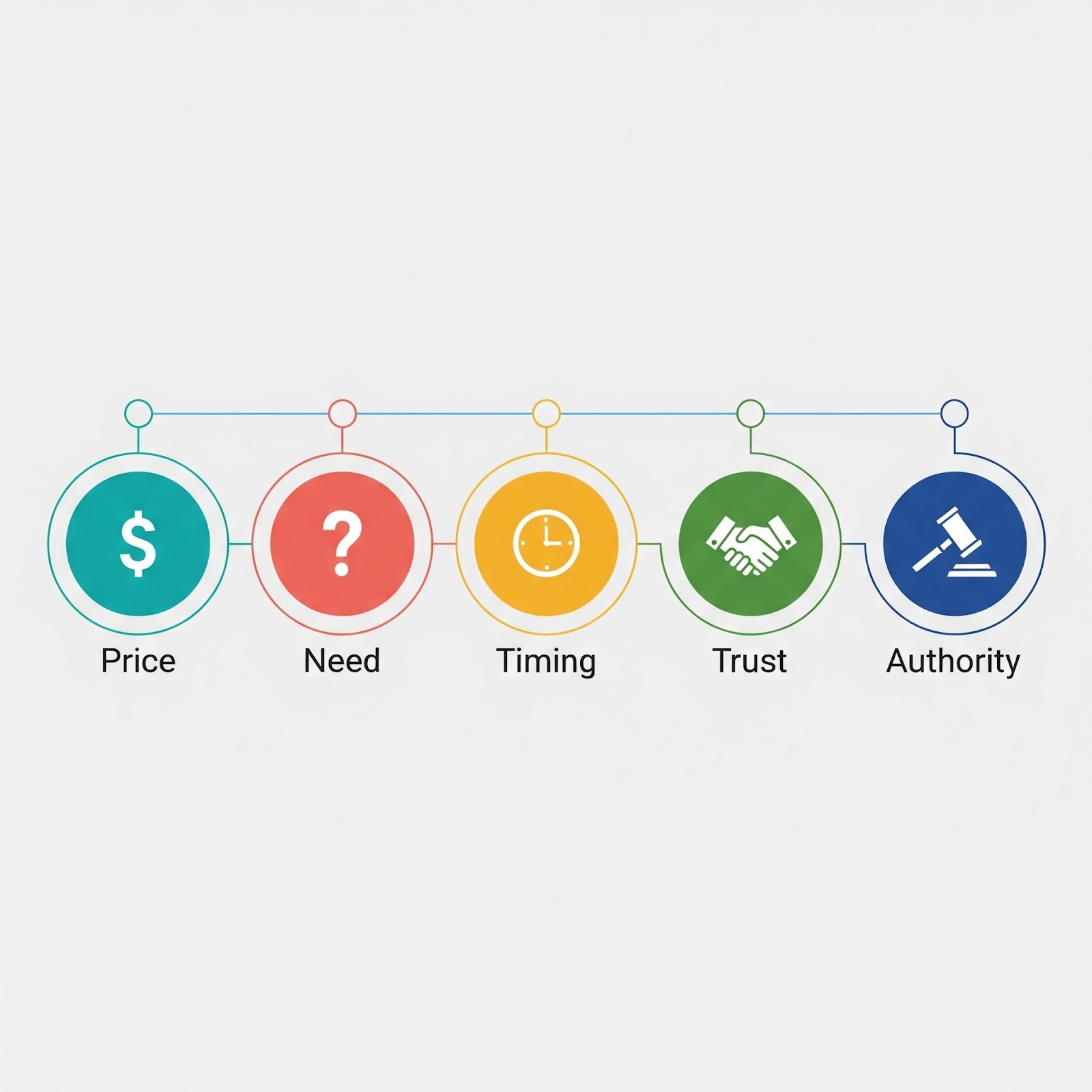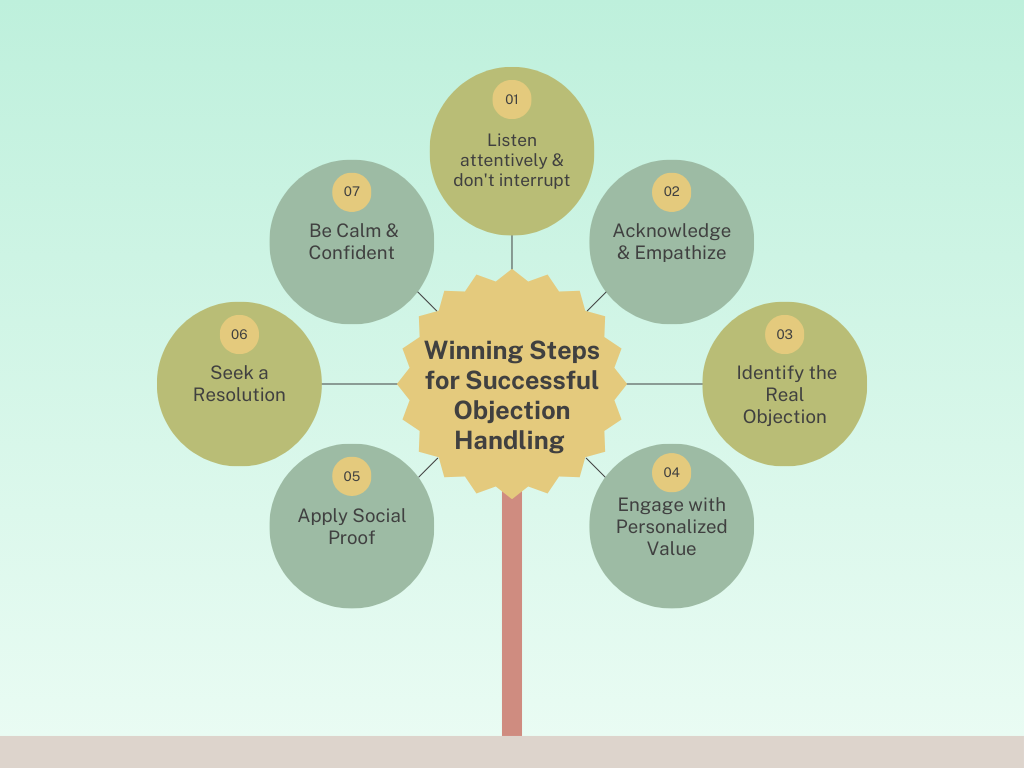Winning Steps to Handling Objections
Each salesperson has seen it: the dreaded pause and then "I don't know" or "It's too costly." Objections are frustrating, but they are checkpoints. They indicate that the prospect is considering your offer, weighing their options, and thinking about making a purchase.
The actual distinction between a high-performing representative and merely an average representative is how confidently you handle objections.
In this blog, we'll discuss:
- What is objection handling?
- Why sales objection handling is mission-critical.
- A step-by-step guide to becoming an expert.
- The key to handling objections successfully.
- The best tools for training teams to handle real-time objections.
What is Objection Handling?
Handling Objections is the science and art of responding to a buyer's objections so that they build trust, solve for value, and advance the conversation.
Objections typically appear in a couple of ways:

- Price – "It's too expensive."
- Need – "I don't think we necessarily need this."
- Timing – "Let's revisit this next quarter."
- Trust – "I don't think your solution will work for us."
- Authority – "I have to get my boss's approval."
Rather than fighting these, effective salespeople see objections as buying signals. If a person is objecting, they're interested enough to inquire instead of sending you away.
Why Handling Objections in Sales Matters More Than Ever
Types of Objections in Sales
Every sales rep runs into objections, it’s just part of the job. The good news? Most pushbacks you’ll hear actually fall into a few familiar buckets. Once you know the types of objections in sales, you can prepare for them and handle them with confidence.
1. Price Objections
Probably the most common one: “It’s too expensive.”When this comes up, it’s rarely about the number itself, it’s about whether the buyer sees enough value to justify it. That’s your cue to connect price with outcomes, not just features.
2. Need-Based Objections
Sometimes prospects simply don’t think they need what you’re offering. The trick here is to dig deeper with discovery questions. Often, there’s an underlying problem they haven’t connected to your solution yet.
3. Timing Objections
“This sounds great, but not right now.” You’ve heard this one before. It’s a classic delay tactic, but it can be turned around by showing what waiting actually costs them in lost revenue, efficiency, or missed opportunities.
4. Trust or Risk Concerns
If someone isn’t sure your product will deliver, or they worry about switching from their current setup, it’s less about your pitch and more about reassurance. Real stories like customer testimonials or case studies, go a long way here.
5. Authority and Decision-Maker Barriers
Nothing stalls a deal faster than realizing your contact isn’t the final decision-maker. That’s why it’s important to map out the buying committee early and get champions who can help you reach the real decision-makers.
Want practical ways to respond to each objection? Check out our guide on how to handle objections in sales calls.
Customers in 2025 are informed and more time-constrained. They research, compare shops online, and often come to the negotiating table with healthy skepticism. According to Salesforce's State of Sales Report, 82% of B2B buyers expect sales reps to be trusted advisors, not product pushers.
This makes objection handling a necessary skill because:
- It converts doubt into confidence.
- It reveals the hidden decision-making factors.
- It reduces the sales cycle by avoiding hesitation at the beginning.
- It prevents ghosting by not allowing matters to remain suspended.
Without objection handling, even the best product demonstrations or price presentations may falter.
Winning Steps for Successful Objection Handling

1. Listen attentively and don't interrupt
The desire to respond reflexively is overpowering, yet heedful listening does two things:
- It assists you in completely grasping the issue.
- It treats the customer with respect.
Example:
Prospect: “I’m worried this won’t integrate with our ERP.”
Rep (after listening): “Got it — can you share which ERP system you’re using?”
Listening first shows respect and keeps the door open.
2. Acknowledge and Empathize
Never dismiss or downplay an objection. Instead, affirm it.
Example:
Prospect: “This looks expensive.”
Rep: “I understand. Many of our customers felt the same initially, before they realized the cost savings.”
Empathy eliminates defensiveness. You're no longer "selling"; you're collaborating.
3. Identify the Real Objection
What they're saying isn't necessarily what they mean. It's a cover for fear of change, risk, or integration issues.
Example questions:
- “Could you tell me more about what’s holding you back?”
- “If budget wasn’t an issue, would this solution work for you?”
This distinguishes surface objections from fundamental objections.
4. Engage with Personalized Value
Don't fight objections with facts about the product. Restate your response around the value to the buyer.
Example:
Instead of: “Our tool automates CRM updates.”
Say: “Our automation frees up 10+ hours a week for each rep — time they can spend on closing deals.”
This ties your solution to what matters most: business outcomes.
5. Apply Social Proof
Buyers believe other buyers. Use narrative, feedback, or studies that mirror their situation.
Example:
“One of our SaaS clients your size had the same concern, but after implementing, they boosted the pipeline by 20% in three months.”
This diminishes risk perception and creates credibility.
6. Seek a Resolution
Don't presume that you've handled the objection, confirm it.
Example:
Rep: “Does that address your concern about reporting accuracy?”
Prospect: “Mostly, but I’d like to see a case study.”
Rep: “Happy to share one — would you like me to walk you through it now?”
This keeps you in sync before going ahead.
7. Be Calm and Confident
Objections are a process, not an attack. The best reps stay optimistic, persistent, and customer-focused even when faced with stubborn resistance.
Example:
Prospect: “I don’t think this is the right fit for us.”
Rep (calmly): “I respect that. Could you share which part doesn’t feel like a fit? That way I’ll know if it’s timing or something we can address together.”
Staying composed builds credibility and keeps conversations constructive.
What Is the Key to Handling Objections?
The Key to Handling Objections Effectively
The key to handling objections is preparation and flexibility.
- Preparation: Prepare for the most frequent objections in your industry and rehearse responses.
- Flexibility: No script can ever be prepared to cover all situations. The salespeople must improvise in the moment, reacting by tone, situation, and customer requirements.
According to RAIN Group Research, top-performing salespeople are 64% more likely to be experts at re-framing buyer objections compared to average salespeople.
What are the best tools to train sales teams on handling live customer objections?
Best Tools to Train Sales Teams on Objection Handling
Traditional workshops and roleplays are useful but insufficient. Enablement in today's sales environment needs to be in real-time and AI-based.
Some useful tools are:
- Conversation Intelligence Platforms: Record and analyze calls to identify objection moments. These platforms, like Gong and Pepsales AI, automatically transcribe and analyze sales calls to provide insights into what reps are saying, how they're saying it, and what's working (or not).
- AI Sales Copilots: Provide real-time conversation flows and recommendations on calls to allow reps to respond accordingly. Tools such as Pepsales AI Copilot and Clari Copilot listen in on live calls and offer prompts to the rep.
- CRM-Integrated Training Tools: Log, track, and leverage objection data to fuel ongoing improvement. Tools like Salesloft Conversations and HubSpot Sales Hub can connect with your CRM to automatically log call summaries and key moments, including objections. This allows managers to run reports on the most common objections their team faces and tailor future training sessions or content to address those specific challenges.
These aids bridge the gap between practice and performance.
How Pepsales AI Empowers Objection Handling
Sales objections don’t just need answers, they need smart, in-the-moment responses. This is where Pepsales AI Copilot makes a huge difference. Instead of leaving reps to improvise, it equips them with real-time coaching, proof points, and analytics right when objections arise.
Here’s what objection handling looks like before vs. after using AI tools:
Conclusion: Turn Objections into Growth Opportunities
Objections are not deal breakers; they are deal makers if managed well. With listening, empathy, value reframing, and the proper tools, salespeople can turn pushback into progress.
That's where Pepsales AI fills in. With real-time coaching, AI-powered objection handling, MEDDPICC scoring, and automated CRM updates, your reps will never be in doubt. Each objection is a chance to strengthen the relationship and advance the deal. Rocketium saw a 180% potential improvement in their win rate and a 75% potential decrease in sales cycle length after using the platform. You can read more about their success here.
Want to empower your team to be skillful objection handlers?
Book a demo with Pepsales AI and turn every "no" into a stepping stone to "yes."
FAQ
1. What does handling objections really mean in sales?
Handling objections means addressing a buyer’s concerns like price, timing, or trust, so you build confidence, show value, and keep the deal moving forward.
2. What are the 5 main types of objections in sales?
Most objections fall into just a handful of categories: price, need, timing, trust, and authority. Once you know these patterns, you’ll realize prospects often say the same things in different ways, it’s not random, and that makes it easier to prepare.
3. Why do prospects raise objections in sales?
Objections usually mean the buyer is interested, but not fully convinced yet. They might be worried about cost, timing, or risk. Instead of treating it like a “no,” think of objections as a sign they’re still in the conversation.
4. How do you handle price objections in sales?
When someone says “it’s too expensive,” what they’re really asking is, “Is this worth it?” The best response is to connect your solution to outcomes they care about like saving time, cutting costs elsewhere, or increasing revenue rather than just defending your price tag.
5. What’s the difference between an objection and a rejection?
A rejection is a hard stop, they’re not interested at all. An objection is more like a speed bump. The buyer is curious, but something’s holding them back. Great reps know how to slow down, listen, and guide the prospect past that hesitation.
6. How can AI tools make objection handling easier?
AI tools like Pepsales AI act like a coach sitting beside you on calls. They suggest responses in real time, remind you of proof points, and even show which objections come up most often across your deals. That way, you’re never caught off guard, and every objection becomes a chance to move closer to a “yes.”





.avif)




.avif)
.avif)
